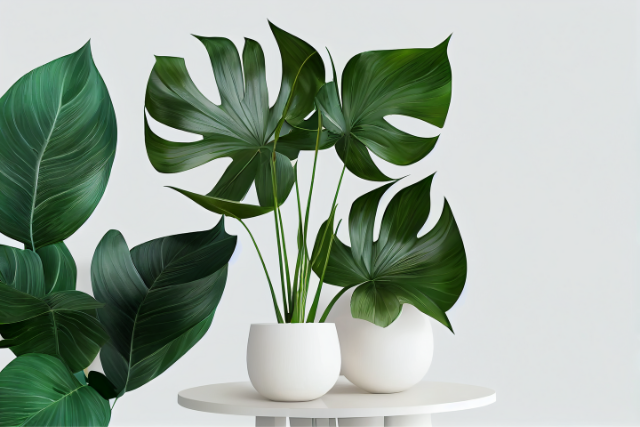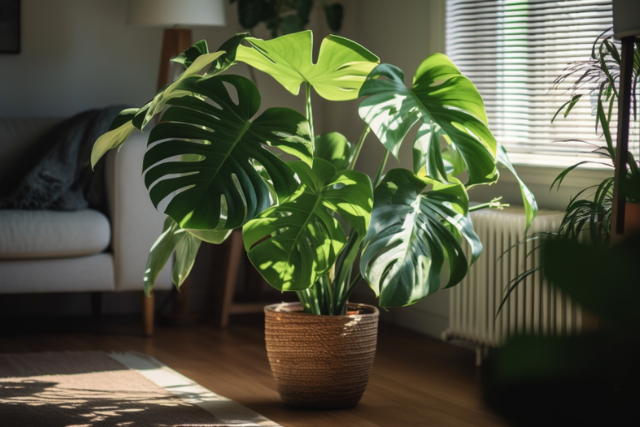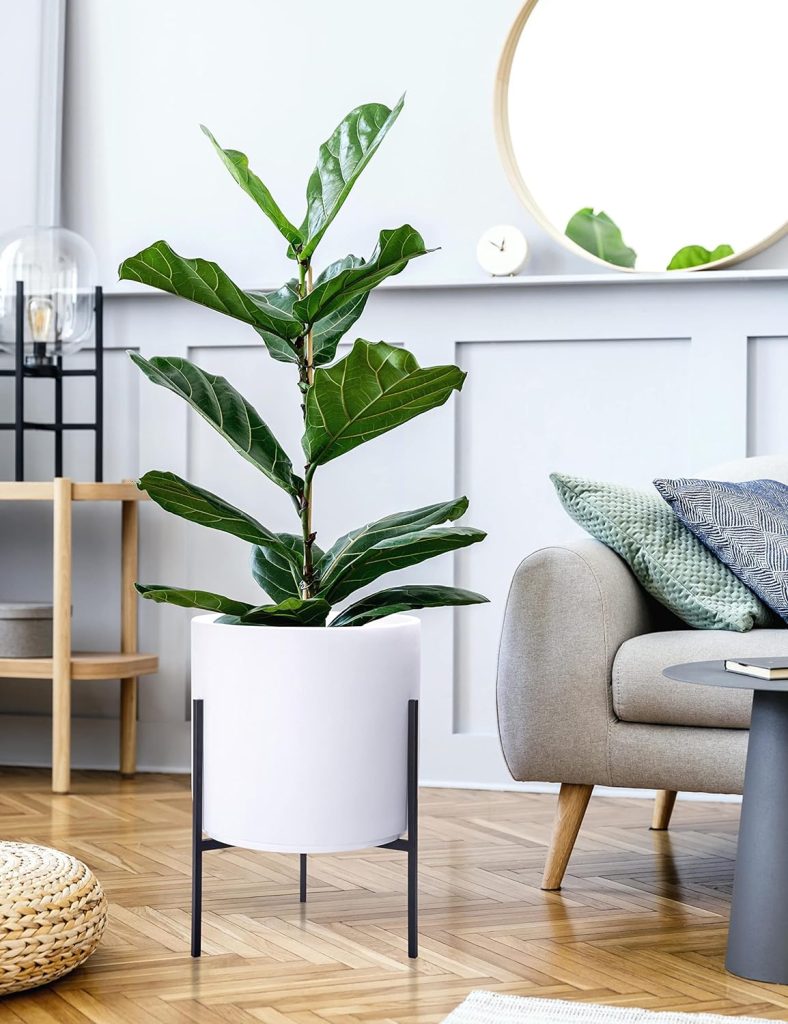This complete Best Pot for Monstera review will make it a snap to find a great pot that will help your Monstera thrive!
Monstera deliciosa, is also called split-leaf philodendron, or in my case for my college dorm – Phil (I wasn’t terribly creative back then!). They are easy to grow, even I didn’t kill mine, and they can get really big.
Ease of care and their huge size may be why so many people enjoy adding these plants to their home. If you have one, or are planning on getting one, this review will help you find the perfect home within your home for your Phil.
[vision id=”1″]
Round Up of Best Pot For Monstera
Best Assorted Sizes: Kante Lightweight Concrete Tall Planters (Set of 3)
Best Tall Planters: Kante Tall Planters Large Tapered
Best Plastic Planter: Veradek Block Series Plastic Planter
Best Large Cacehpot: D’vine Dev Modern Planter with Heavy Duty Stand
The Monstera plant, a beloved household favorite, is celebrated for its low-maintenance care. Yet, there is one often-overlooked factor that will make a differences between a healthy, lush Monstera and one that struggles: which pot you choose to plant it in.
In this comprehensive guide, we will delve into the impact of pot choice on your Monstera’s health and growth and help streamline your plant care routine. We’ll also provide invaluable insights into selecting the best pot for your Monstera, along with pots to avoid. Are you ready to embark on this green journey? Let’s kick things off with some things you may not know.
Just a heads up: ZenQuestLife.com is a participant in the Amazon Services LLC Associates Program and other affiliate programs. That means that you should assume all links to products or services for sale are affiliate links. If you click on a link and make a purchase, you won’t pay one penny more but I may earn a commission.

5 Key Features to Consider in a Monstera Pot
The perfect pot for your Monstera should not only be functional but also a visually appealing addition to your space. It must create the ideal environment for growth, fostering proper stability, drainage and the ability to hold enough soil, as well as offering room for the roots to flourish. Here are the five essential features to contemplate when choosing the ideal pot for your Monstera.
- Drainage:
Drainage reigns supreme when it comes to Monstera pots. This plant abhors having “wet feet,” and prolonged exposure to overly damp soil can lead to dire consequences like root rot. While the material, aesthetics and size of the of the pot are customizable to suit your preference and environment, one non-negotiable factor is a pot that has holes for drainage. - Size:
Selecting the right pot size hinges on your Monstera’s age and size. An appropriately sized pot will support the fast grow rate of this plant. Using a pot that’s on either end of the spectrum, too big or too small, can create a host of problems. A small pot can lead to your Monstera becoming pot-bound, with roots emerging from he drain holes at the bottom (not ideal!). That can result in under-watering and stunted growth. On the other hand, an oversized pot can hinder soil from drying out in between watering, potentially leading to overwatering. An easy to remember rule of thumb is to choose a pot that leaves 1″ of space on both sides of the root ball and at least 2″ from the roots to the bottom.
- Stability:
Monstera plants, particularly Monstera deliciosa and related species, can grow impressive stems and leaves, reaching heights of 7+ feet indoors and can have leaves spanning nearly 2 feet in width. Varieties such as M. obliqua, Monstera adansonii, M. esqueleto, and M. epipremnoides will require support to showcase their iconic fenestrations once they start climbing. All species of this plant can be quite top-heavy, necessitating pots that offers stability. - Material:
The best post for Monstera will be made of certain materials. The material is very important, just like drainage is an important consideration. It can influence how often you water, plant stability, general plant health and root aeration. The top choices for pot materials include plastic, terracotta, and glazed ceramic, each with its own set of advantages and disadvantages. - Aesthetics:
While aesthetics may not directly impact plant growth, Monstera is renowned for its beauty. It deserves a pot that complements its elegance. Once you’ve identified the right pot that best caters to your plant’s needs, enjoy exploring the various container designs and cachepots that harmonize with your home style.
The Ideal Material for Your Monstera Pot
Monstera plant containers are commonly made from: plastic, terracotta, and glazed ceramic. Each material comes with its own pros and cons that should guide your choice.
Plastic:
Plastic is a popular pick for Monstera plants due to their affordability, versatility, and lightweight nature. They won’t shatter if they take a tumble and aid in keeping the soil moist. But, taller, top-heavy Monsteras may require additional support in plastic pots. Plastic offers little insulation against cold temperatures and can become brittle when exposed to prolonged sunlight. If you are likely to overwater, be mindful that the non-porous nature of plastic pots can make your Monstera more susceptible to root rot.
Terracotta:
Unglazed terracotta pots look good and are budget friendly. They are 100% recyclable, making them a greener choice compared to plastic. They provide superior insulation for your plant’s roots, enhance soil aeration, and can be more stable for larger, mature plants owing to their weight. Nonetheless, since terracotta is porous, it can be be a double-edged sword. It has the potential to wick too much moisture out of the soil, leaving your Monstera thirsty and at risk of underwatering.
Ceramic Pottery:
Ceramic pots, often glazed, blend the merits of both terracotta and plastic. They can stabilize your taller plants, while offering insulation to the roots. Despite being made of clay, they don’t wick excessive moisture due to their glazing. The bonus? They are available in dazzling colors, designs and shape.
But, ceramic pots may not offer the same amount of soil aeration as a terracotta pot would provide. If you use a pot mix that dosn’t drain well, between the porous clay and the glazing may hold in too much moisture and keep the soil too damp, a condition Monstera dislikes. Plus, they often come with a higher price tag, making them the costliest potting option.
Here’s the catch with ceramic pots—most lack drainage holes at the bottom. So, don’t ever plant your Monstera in them. Instead, place your plant in a plastic pot first, then insert it into the ceramic vessel. Alternatively, if you’re comfortable using a drill, just use a diamond bit and drill drainagine holes in the base of the pot yourself.
Selecting the Perfect Pot for Your Monstera
Now you know the essential features and material differences, it’s time to make an informed decision about the pot that will house your Monstera. Your choice depends on factors like your watering habits, the plants size and the growing conditions. Let’s delve deeper.
Best Container for Repotting Your Monstera:
Generally, you’ll be repotting your Monstera approximately about every 2 years (or when its roots start peeking through the drain holes). Opt for a new pot that’s one size larger or has a diameter top measurement at least 2″ wider.
Best Pot for Overwatering:
If you tend to overwater your Monstera, consider a terracotta pot. Terracotta counteracts too much moisture it also fosters good soil aeration, helping stave off root rot.
Best Pot for Underwatering:
For the forgetful gardeners, plastic is the best material for your pot. Monstera prefers moderately moist soil, plastic can help keep roots from drying out too fast.
Best Pots for Low Light, Cool Rooms:
Monstera thrives in warm, well-lit environments. If you’re housing your Monstera in a cooler, low-light space, choose a terracotta pot. It helps maintain proper soil moisture and root health.
Best Pots for Low Humidity Homes:
Monsteras adore humidity. In drier environments or if your home’s humidity hovers below 40%, opt for a plastic pot. It retains soil moisture, creating a more favorable environment for your plant.
Best Pot for a Big Monstera Plant:
For grand Monstera specimens, deep terracotta or glazed ceramic pots are your top pick. These containers provide much-needed stability when they are filled up with soil. They’re perfect for the substantial species like Monstera deliciosa and its variations, including Thai Constellation, Brazilian Common Form, Mint Monstera, Albo-Variegata or Aurea.
Best Pot Choice for Trailing Monstera:
Trailing Monsteras are relatively flexible regarding pot type. You can opt for a hanging pot made of plastic, a coco fiber lined basket, or last a terracotta pot. Be mindful, though, that clay and ceramic pots are pretty heavy. They aren’t ideal for hanging unless you have a very secure hook attached to a stud. If not secured they can fall, break and make a huge mess.
The Best Choice Of Pot for Climbing Monstera:
If your Monstera is using sphagnum moss or coir poles, you need a heavy planter to prevent it from toppling. Terracotta, ceramic, or pots made of concrete are ideal choices. If you prefer plastic pots, consider adding a decorative cover or cachepot to enhance stability.
Best Pot For Monstera Outdoor Plants:
Monstera planted outside, have very different needs than when grown inside. They receive more sunlight, but require additional watering, and may contend with high winds and possibly even your neighbors dog. Terracotta reigns supreme for outdoor use. Its stable, reducing the risk of toppling due to pets, high wind or even wildlife. In climates with high humidity, where it will take longer for water to evaporate, terracotta’s moisture-wicking properties will provide more airflow for the roots. However, if you’re in a climate that is dry and hot, or if your Monstera is in a sunny garden spot, plastic pots are more suitable. They slow down soil drying so you don’t have to water as often. For added stability outdoors, consider a heavier, glazed ceramic container in place of plastic.
Selecting the Best Pot Size for Monstera Cuttings:
Propagation is an exciting journey with Monstera, especially when you root cuttings in water. As soon as the roots reach at least 2″ in length, it’s time to transition them into soil. The challenge lies in choosing the right pot size for baby plants, where their small roots aren’t yet equipped to absorb ample water and might risk rotting in an oversized pot.
For small leave Monstera cuttings, go for a pot with a 3 to 4-inch diameter. For larger-leaved cuttings like Monstera Albo, or Monstera deliciosa opt for a pot that’s 5 to 6 inches wide. Always use nursery pots, or plastic when you transplant rooted cuttings, as they retain moisture, aiding the move from water to dirt.
Pot Types to Avoid. Not all pots are created the same, some may negatively affect your Monstera plants.
Top 4 types of pots to steer clear of and one to use with caution:
Un-Drainaged Ceramic Pots: Avoid ceramic pots without drainage holes at the bottom, as they can trap excess moisture, risking root rot.
Fragile Hanging Pots: Steer clear of clay and ceramic pots for hanging purposes, as they can be too heavy and prone to breakage if they fall.
Inadequate Support for Climbing Monstera: Ensure the planter for a climbing Monstera is heavy enough to prevent toppling. If you opt for a plastic pot, consider using a decorative mask or cachepot for added stability.
Inadequate Outdoor Stability: Using lightweight pots outdoors may lead to wind-related incidents, so prioritize stable containers for your outdoor Monstera.
By understanding these potting nuances and choosing wisely, you’ll provide the ideal environment for your Monstera’s growth and enjoy a thriving, vibrant plant that’s the pride of your home.
What Is A Cachepot?
A cachepot is simply a plant pot that is made large enough to accommodate your plant in it’s original pot. It is essentially a decorative outer pot for the pot your plant is planted in.
Cachepots and decorative masks are excellent for adding a touch of elegance to your Monstera’s container. But, like everything in the world of plants, there are some nuances to consider when using them to ensure the well-being of your leafy companion.
Optimal Sizing:
When selecting a cachepot for your Monstera, it’s important to choose one that’s at least 1/2″ bigger in diameter than the plastic pot. This extra room creates a crucial gap at the top between the 2 pots. Why is this gap significant? Well, it allows any extra moisture to evaporate which can prevent condensation from building up between the plastic pot and the cachepot.
Proper Drainage:
After giving your Monstera a good watering, it’s essential for the pot to drain a minimum of thirty minutes before placing it inside the cachepot. Otherwise, any surplus water will accumulate in the bottom of the decorative pot, creating an unfavorable environment for your plant.
Frequently Asked Questions
Does Monstera Thrive When Rootbound?
Not at all. Monstera species are equipped with a fast growing, robust root systems. Keeping them confined in a small pot for an extended period hampers their ability to absorb sufficient nutrients as well as water. This results in stunted growth and a gradual decline in overall health. To prevent this, make it a rule of thumb to repot your plants every two years.
Is Trimming Monstera Roots an Option?
Technically, you can trim Monstera roots, but it’s not the most recommended practice. Pruning the roots may shock the plant, particularly if it’s still young. If you’re relatively new to gardening, the safer approach is to repot the Monstera into a bigger container. If you’ve got a bit more experience under your belt, and you’re feeling daring, a sterilized, sharp blade to trim about 1/4 of the outer roots will work.
Do Rocks Belong in the Bottom of a Monstera Pot?
In short, no. Despite popular belief, placing pebbles or small rocks in the bottom of the pot won’t enhance drainage. Quite the opposite, in fact. The excess water will collect in the lower soil layer, creating a waterlogged, oxygen-deprived environment that encourages the growth of bacteria and fungi, ultimately leading to the dreaded root rot.
Now you know what you need to know to find the prefect cachepot for your Monstera. A cachepot that will promote optimal moisture control, and ensure the well-being of your beloved plant.
Why Have Plants In Your Home?
Having plants in your home has many benefits. There have actually been studies to determine if these benefits are real or “in our minds”. And, the benefits listed below have been shown to be real!
Common health benefits of adding some living plants to your home are:
- Less stress
- Calming affect
- Better quality of your indoor air
- Increase humidity levels
- Improve your immune system. This one may be more about the decreasing stress levels which does have a positive impact on your immune system.
Best Pot for Monstera – The Bottom Line
As you’ve already read, there are several options when looking for a good pot for your Monstera. Ensure the necessities are there like proper size and drainage, etc. but beyond that, it’s up to you to decide the style and color you want.
We’ve listed some of the pots that will not only work great for your Monstera, and other plants too, but they look good and meet the above criteria as well.
Here are our top picks:
Best Assorted Sizes: Kante Lightweight Concrete Tall Planters (Set of 3)
Best Tall Planters: Kante Tall Planters Large Tapered
Best Plastic Planter: Veradek Block Series Plastic Planter
Best Large Cacehpot: D’vine Dev Modern Planter with Heavy Duty Stand

